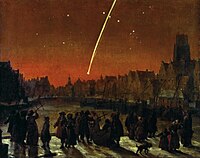Great Comet of 1680
au | |
| Eccentricity | 0.999986[1][2] |
|---|---|
| Orbital period | ~10,400 yr[3] |
| Inclination | 60.7° |
| Last perihelion | December 18, 1680[1][2] |
| Next perihelion | Unknown |
C/1680 V1, also called the Great Comet of 1680, Kirch's Comet, and Newton's Comet, was the first comet discovered by telescope. It was discovered by Gottfried Kirch and was one of the brightest comets of the seventeenth century.
Overview
The comet was discovered by
While the Kirch Comet of 1680–1681 was discovered by – and subsequently named for – Gottfried Kirch, credit must also be given to
Friday, November 19th, 1680. This morning about an hour before the day we observed a comet to appear a degree N. from the bright in Libra. The body thereof seemed dull, and its tail extended itself 18 or 20 degrees in length, being of a pale colour and pointing directly N.N.W. Our prisoners hereupon reported to us that the Spaniards had seen very strange sights, both at Lima, the capital city of Peru, Guayaquil, and other places, much about the time of our coming into the South Seas.[8]
Although it was undeniably a
Gallery
-
The comet as it appeared above Beverwijk on 22 December 1680.
-
The Great Comet of 1680 over Nuremberg
-
Commemorative medal depicting the comet, Hamburg, 1681
-
"Cometa apparsa in Roma l'Anno 1680". From an issue of Mercure Galant, published in Paris
-
The comet on the background of the signs of the Zodiac in the winter of 1680–1681
-
A 1727 chart of the solar system up to the orbit of the planet Saturn, with the track of the 1680 comet, and two others
-
Front page of Exposisión astrónomica de el cometa by Eusebio Francisco Kino, 1681
See also
References
- ^ a b c d "JPL Small-Body Database Browser: C/1680 V1" (1681-03-19 last obs (Encke: 125-day data arc)). Jet Propulsion Laboratory. Retrieved 26 July 2011.
- ^ a b c d "JPL Dastcom Comet Orbital Elements". Archived from the original on 6 September 2008. Retrieved 10 February 2010.
Num Name ... q ... Tp ... C/1680 V1 (1680 V1) ... 0.00622200 ... 16801218.48760
- ^ Barycenter. Ephemeris Type:Elements and Center:@0 (For epoch 1800 orbit period is "PR= 3.8E+06 / 365.25 days" = ~10,400 years)
- ISBN 9780387095134.
- ^ a b Donald Yeomans. "Great Comets in History". Jet Propulsion Laboratory/California Institute of Technology (Solar System Dynamics). Retrieved 1 August 2007.
- ^ NASA JPL Horizons ephemeris 2022–2030
- OCLC 1730711. Reprint 1948.
- ISBN 978-0-87380-176-8. Retrieved 5 April 2021.
- ^ Tony Hoffman. "A SOHO and Sungrazing Comet FAQ". Archived from the original on 5 August 2012. Retrieved 6 February 2006.
- ^ a b Jardine, Lisa (15 March 2013). "A Point of View: Crowd-sourcing comets". Magazine. BBC News. Retrieved 20 May 2013.
External links
- The Great Comet of 1680 Over Rotterdam (APOD28 October 2013)








![The orbit of the comet of 1680, fit to a parabola, as shown in Isaac Newton's Principia[3]](http://upload.wikimedia.org/wikipedia/commons/thumb/d/df/Newton_Comet1680.jpg/120px-Newton_Comet1680.jpg)



